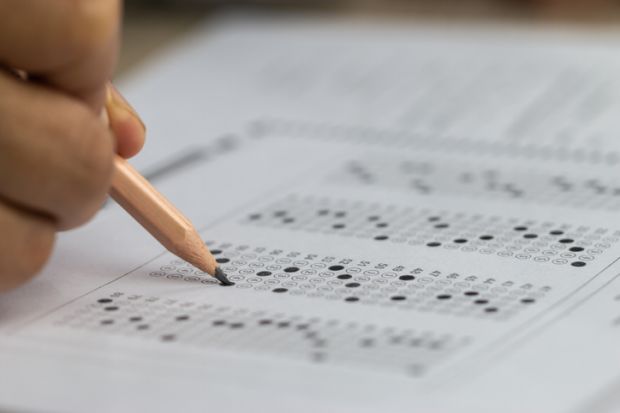Since the beginning of the COVID-19 pandemic in 2020, over 1,900 universities have changed their SAT and ACT policies. More than 80% of four-year colleges have become test-optional, and some schools aren’t accepting test scores at all. This shift in test-score reliance marks the emergence of a discussion on the ethics of standardized tests. While many believe that the SATs are rooted in malpractice and prolong racial inequalities, the facts show standardized testing is effective in providing a measure of academic intelligence and predicting future success. No one believes that test scores should be the only criteria for college admissions, but — on account of intensified grade inflation and vast community differences — universities must maintain some sort of standardized evaluation.
In 2020, at the University of California, a faculty committee concluded that test scores better predict student success than high school grades. Another recent study into student success at Ivy-Plus schools (Ivy League schools plus other elite colleges like Duke University, Stanford University and the University of Chicago) showed a weak correlation between high school grades and college grades. Instead, the study showed the relationship between SAT scores and college grades to be much stronger and concluded that if colleges were to eliminate the SAT, they would have a much worse idea of how applicants would perform at their schools.
SAT performance is also strongly associated with performance after college, further proving the test’s accuracy in measuring students’ capabilities. The study of student success at top-ranked universities showed a strong, positive correlation between SAT- or ACT-equivalent scores and working at a prestigious firm. Like college performance, high school grades were weakly correlated with post-graduation success.
High school grades are likely failing at predicting success because of grade inflation. An “A” (now America’s most popular high school grade) is no longer impressive. There is no chance of excelling if the highest grade becomes the benchmark. Between 1998 and 2016, the average high school GPA rose from 3.27 to 3.38, but the average SAT score fell from 1026 to 1002. We’ve already established the SAT as a better predictor of success, so how can grades be improving if test scores are falling? The reason: grades are not standardized. If a teacher wants to award all students an A, nothing stops them. Thus, the high school GPA loses some credibility.
The main argument against SATs is that the test perpetuates racial inequalities. According to College Board data, on average, Black, Hispanic and Latino students score lower on the math section of the SAT. Opponents of standardized testing argue that the SAT reinforces existing race gaps in America. However, if we consider the SAT a measure of academic intelligence, that intelligence is fostered by education and privilege. Inequality in America leaves people of color at a disadvantage: Black and Hispanic children are disproportionately concentrated into high-poverty schools with fewer resources.
A standardized test will inherently reflect educational deficiencies. That’s what it’s supposed to do. We cannot change our measures and meaning of academic intelligence to ignore the fact that our nation fails to educate people equally. That would be ignoring the root of the problem and thus perpetuating inequality. In fact, maintaining the SAT as part of the college application process can give students from underprivileged communities more opportunities for success. At Harvard University, economist Susan Dynarski outlined the impacts of standardized testing in Michigan in 2007: “For every 1,000 low-income students who had taken the test before 2007 and scored well, another 480 college-ready, low-income students were uncovered by the universal test.”
The Massachusetts Institute of Technology serves as a case study for the positive impact of standardized testing on diversity. During COVID-19, the school suspended its test requirement. When the requirement was brought back two years later, MIT admitted the most diverse class in its history. Additionally, 20% of the class was awarded Pell Grants, which provide lower-income students the means to attend school. Without the SATs as a requirement, admission officers have to turn to other indicators that reflect America’s racial inequalities even more. Low-income students are disproportionately students of color. That said, factors considered during the admission process that favor wealthy families, in turn, typically disproportionately leave students of color at a disadvantage. Extracurricular activities, for example, are weighed in the college admissions process, and they are dominated by middle- and upper-class students. The same goes for music lessons. Wealthy parents can afford to send their kids to private schools that specialize in preparing students for the Ivy League world. While privileged students can also afford SAT prep courses, the demographics of SAT results show disparities like those revealed by the National Assessment of Educational Progress, a nationwide test for elementary and middle school students. Students can not take preparatory courses for that exam.
So, standardized tests have a case for being the most equitable aspect of college admissions. For some educational reformers, that isn’t enough. Eddie Comeaux, who is a professor of higher education at the University of California, acknowledges that the SAT is a strong indicator of future performance. However, he believes colleges should prioritize diversity over academics or success. Comeaux is part of a group of reformers who believe that the purpose of higher education is to lift social mobility: to provide opportunities for disadvantaged communities, not for privileged ones. Diversifying education is essential; it’s something we’ve been doing as a country and will continue to do. But prioritizing racial diversity over any other aspect of education challenges the notion of what it means to be a prestigious, competitive and effective institution of higher education.
Schools like Yale University and Harvard are considered “elite” because they only take the best students. Acceptance is an achievement. Colleges like these work to cultivate students into expert scientists, mathematicians, philosophers, politicians and countless other roles from which these students can make the world a better place. But if elite schools stop taking the smartest kids and instead pull from a “lottery,” as Comeaux suggests, that competition disappears. Most colleges and universities (especially Ivy League schools) already place special emphasis on social mobility. But that can’t be the only factor. Otherwise, students have no reason to strive for improvement in academics, artistry, athletics and other facets of their application within their control.
Lindsey Osit, FCRH ’24, is a journalism major from South Windsor, Conn.









































































































































































































